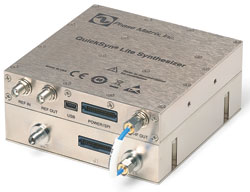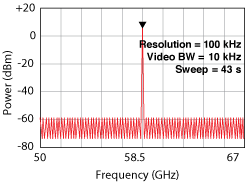
An increasing number of applications in the millimeter wave (mmWave) frequency range are driving the need for portable low-cost CW signal sources. The ever-growing hunger for speed is moving technology towards higher frequencies to achieve bandwidth advantage. Millimeter waves not only enable multi-gigabit rates required in transmission links for emerging broadband wireless networks but also offer the advantages of sharper beams, smaller size and ease of frequency reuse. From existing and growing Ka-Band satellite communications, to Ka and E-Band cellular backhaul radio markets, to emerging 5G and automotive radar, and multiple commercial applications in the license-free 57 to 64 GHz band, the marketplace is creating new challenges and fueling the need for mmWave components, sources and test gear. Presently, commercially available stand-alone frequency multipliers are used with expensive broadband signal generators to generate CW mmWave signals. These conventional instruments have many features such as pulse and AM modulation that are either not needed or are not usable after the frequency multiplication.
To address today’s market requirements, National Instruments is introducing a series of banded frequency synthesizer modules based on its existing industry-leading QuickSyn microwave synthesizers. Integrating QuickSyn technology with frequency multipliers and amplifiers, provides a unique solution covering the popular frequency bands (i.e., 27 to 40 GHz, 50 to 67 GHz and 76 to 82 GHz). The new QuickSyn mmWave synthesizer modules offer an unmatched combination of fast-switching speed, low phase-noise performance and medium power consumption in a compact format. These new offerings present a very cost-effective solution for applications requiring a stable and clean CW mmWave source.

Figure 1 Phase noise performance.
Phase Matrix (now NI Microwave Components) first introduced the revolutionary QuickSyn technology in 2010 with its full-featured QuickSyn synthesizers covering 100 MHz to 10 GHz and 200 MHz to 20 GHz (Models FSW-0010 and FSW-0020 respectively). These industry-first modules—with their variety of features and functions including AM, FM and pulse modulation, SPI and USB control interfaces—satisfied a major market need and are a popular choice among RF/microwave engineers around the world. Then in 2013, NI Microwave Components introduced the “lite” version of the synthesizers, featuring fixed-power CW covering 650 MHz to 10 GHz and 650 MHz to 20 GHz (models FSL-0010 and FSL?0020 respectively). The QuickSyn Lite synthesizers, like the full-featured synthesizers, employ phase-refining technology based on fundamental VCOs up to 20 GHz. QuickSyn technology enables instrument-grade spectral purity, 100 µs switching speed from any frequency to another frequency within the covered range, and reduced susceptibility to microphonic vibration. In addition, the use of advanced direct digital synthesis (DDS) enables a very fine frequency resolution of 0.001 Hz without the common penalty of elevated spurs.
All QuickSyn synthesizers use a highly stable internal TCXO that is factory calibrated to a GPS standard to ensure adequate accuracy and long-term stability (better than 1 ppm) of the synthesized signal. The synthesizer modules can also supply the same stable 10 MHz reference signal to the outside world. The internal oscillator can be locked to an external 10 MHz reference as well. While the full-featured Quicksyn sources offer signal modulation and power control, the QuickSyn Lite versions provide a fixed power CW signal.

Figure 2 FSL-2740 spectral performance.
The new QuickSyn mmWave synthesizer modules use a frequency multiplier module that is designed to mount on top of a standard QuickSyn Lite module, extending the frequency range to mmWave. These new modules are powered and controlled by the same +12 V supply of the base 20 GHz module, making integration and control simple for the user. The RF input of the frequency extender is also provided by the Quicksyn base module, and like the standard QuickSyn, these new mmWave sources include serial SPI and USB control interfaces and are immediately deployable by connecting them to a PC and a DC power source. A soft front panel allows the user to access frequency control and frequency sweep plus 32K-point LIST mode settings. Additionally, embedded firmware enables these modules to be used as part of integrated auto test solutions.
The modules are designed to supply medium power output in the three popular bands. Care has been taken to minimize sub-harmonics and spurious. In addition to being used as local oscillators in a frequency-converter application, the QuickSyn mmWave modules can easily be used as reference-calibration frequency sources. Also, because of their fast-tuning and high-resolution capabilities, the QuickSyn mmWave modules are ideal for characterizing antennas, semiconductor devices and other components requiring acquisition of large amounts of data in a short time.
QuickSyn Model FSL-2740 provides frequency coverage from 27 to 40 GHz with a minimum output power of +17 dBm and instrument-grade phase noise performance of -105 dBc/Hz at 100 kHz offset and an RF frequency of 40 GHz as shown in Figure 1. The FSL-2740 module can be used for Ka-Band satellite communications applications as well as in wideband, high data rate applications between 28 to 31 GHz. With undesirable spurious products driven below 60 dBc (see Figure 2), the FSL-2740 performs well in backhaul digital radio applications, which utilize the high-end of Ka-Band. In addition, a coaxial 2.92 mm connector is used for RF output.

Figure 3 Typical power vs. frequency performance.

Figure 4 FSL-5067 spectral performance.
QuickSyn Model FSL-5067 provides frequency coverage from 50 to 67 GHz with a minimum output power of +17 dBm. Figure 3 shows typical power vs. frequency performance while Figure 2 shows the FSL-5067 phase-noise performance of -101 dBc/Hz at a 100 kHz offset and an RF frequency of 67 GHz. The FSL-5067 has excellent spectral performance as shown in Figure 4, with in-band spurious products below 60 dBc at 58.5 GHz. Sub-harmonics are better than 40 dBc. The FSL-5067 is designed to support commercial applications in the license-free 57 to 64 GHz band in the U.S. as well as the 60 to 66 GHz band in Japan and Europe. Common applications within this band are in point-to-point as well as point-to-multipoint, including wireless HDMI, WiGig, IEEE802.11ad, wireless gigabit Ethernet and point-to-point high-speed data links with 1 to 2 km wavelength. The FSL-5067 uses a coaxial 1.85 mm connector for RF output.
The QuickSyn Model FSL-7682 covers 76 to 82 GHz with a minimum power output of +10 dBm. Figure 1 shows the FSL-7682 low phase-noise performance of -99 dBc/Hz at 100 kHz offset and an RF frequency of 82 GHz. In-band spurious and sub-harmonics are guaranteed to -60 and -40 dBc respectively. The FSL-7682 is the low-cost source for the bourgeoning field of automotive radar. Millimeter wave radars are a key part of the currently deployed narrowband, long-range radar (LRR) sensors used for collision avoidance applications. Expanding applications within the automotive field include assisted driving and driverless technology require wider bandwidths up to 81 GHz, making the FSL-7682 an attractive choice for design engineers. The FSL-7682 uses a WR12 waveguide interface for RF output.
QuickSyn technology not only allows excellent performance, increased functionality and small size, it is inherently cost effective, greatly contributing to the product line’s popularity. QuickSyn Lite synthesizers start at below $4,000, and the new QuickSyn mmWave synthesizers are also remarkably affordable and will serve well in many mmWave applications for a variety of industries.
National Instruments
Microwave Components Group
Santa Clara, Calif.
www.ni-microwavecomponents.com
